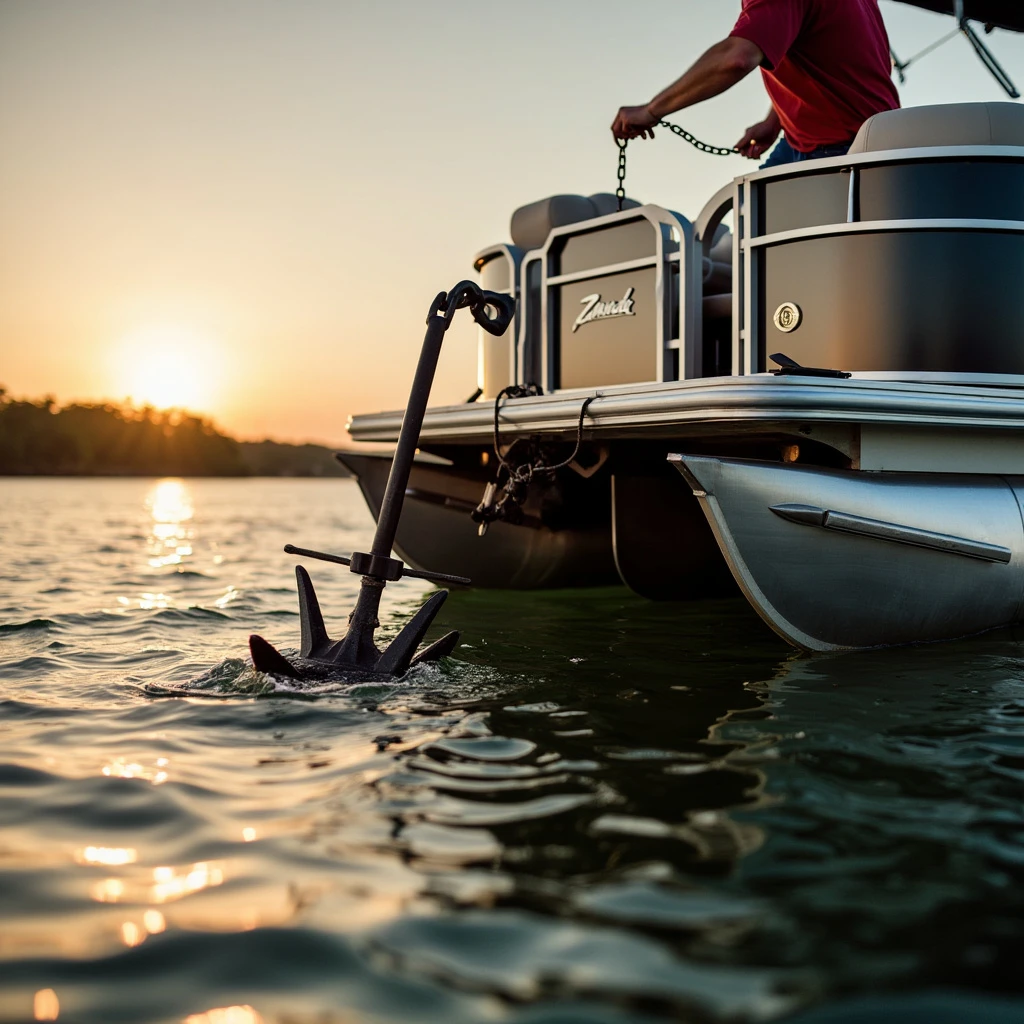Anchoring Your Pontoon Boat
Pontoon boats are a popular choice for water recreation due to their spacious layout and stability. Whether you are spending the day fishing or enjoying a relaxing ride, properly anchoring your pontoon boat is crucial for ensuring a safe and enjoyable experience.
Understanding the Importance of Proper Anchoring
Anchoring refers to the process of securing your pontoon boat in place using an anchor. Proper anchoring is important for several reasons, including:
- Preventing your boat from drifting away in windy or strong currents
- Allowing you to safely swim, fish, or relax without the worry of drifting off
- Keeping your boat in place while docking or loading and unloading passengers
Different Types of Anchors Suitable for Pontoon Boats
There are several types of anchors suitable for pontoon boats, including:
| Anchor Type | Features |
|---|---|
| Fluke Anchor | Lightweight, suitable for small pontoon boats and shallow waters |
| Mushroom Anchor | Heavy and suitable for muddy or sandy bottoms |
| Plow Anchor | Heavy and ideal for deeper waters and strong currents |
It is important to choose the right anchor based on the weight and size of your pontoon boat, as well as the bottom conditions and water depth where you will be anchored.
Choosing the Right Anchor for Your Pontoon Boat
When it comes to anchoring your pontoon boat, the first step is to choose the right anchor that can provide enough holding power to keep you secure. Here are some important factors you need to consider while choosing the anchor for your pontoon boat.
Assessing the Weight and Size of Your Pontoon Boat
The weight and size of your pontoon boat are the most important factors while choosing an anchor. The weight of the anchor must be proportional to the weight of your boat. A heavy anchor is required for a large and heavy pontoon boat, while a light anchor is suitable for a small and lightweight boat. If you have a large boat, you may need multiple anchors.
Considering the Bottom Conditions and Water Depth
You need to consider the type of bottom surface where you plan to anchor your pontoon boat. A muddy or sandy bottom will require a different type of anchor compared to a rocky or weedy bottom. The depth of the water is also important because it determines the length of the anchor chain or rope required to reach the bottom.
Recommendations for Anchor Types and Weight
Here are some recommendations for anchor types and weight depending on the size and weight of your pontoon boat.
| Pontoon Boat Size and Weight | Anchor Type | Anchor Weight |
|---|---|---|
| Up to 20 feet and 1500 pounds | Fluke or Danforth Anchor | 9 to 13 pounds |
| 20 to 24 feet and up to 3500 pounds | Fluke or Danforth Anchor | 13 to 16 pounds |
| 24 to 30 feet and up to 6000 pounds | Plow or Claw Anchor | 22 to 26 pounds |
| 30 to 35 feet and up to 9000 pounds | Plow or Claw Anchor | 26 to 33 pounds |
It’s always better to choose an anchor that’s slightly heavier than recommended to ensure better holding power in extreme weather conditions.
Choosing the right anchor for your pontoon boat is crucial for your safety and peace of mind. After choosing the anchor type and weight, it’s time to prepare for anchoring your boat.
Preparing to Anchor Your Pontoon Boat
Before you set out to anchor your pontoon boat, there are a few things you need to consider and prepare for.
Gathering Necessary Equipment and Accessories
To anchor your pontoon boat, you will need a few key pieces of equipment:
- An anchor – make sure it is suitable for your boat size and the bottom conditions of the water.
- Anchor chain – to connect the anchor to the boat and provide weight.
- Anchor rope – to tie the chain to the boat.
- Fenders – to protect the boat when approaching the shore.
- Boat hook – to help you with attaching the anchor.
Setting Up Your Anchoring System
Anchor setup can seem daunting, but with practice and proper setup, you can anchor safely and confidently. Here are a few tips:
- Attach the chain to the shank of the anchor with a shackle and then connect the rope to the chain.
- Attach fenders to the boat, so it doesn’t collide with anything nearby.
- Let out about five to seven times the depth of the water, paying attention to the scope (the ratio of rope length to the depth of the water).
Safety Considerations Before Anchoring
Before you anchor, make sure everyone on board is aware that safety must come first. The following are tips to keep in mind:
- Give the crew instructions on how to deploy and pull up the anchor.
- Have everyone put on life jackets.
- Be aware of your surroundings and ensure the area is safe to anchor in.
By preparing properly before anchoring, you will be able to anchor your pontoon boat safely and with confidence.
The Anchoring Process: Step by Step
Approaching the Anchorage with Caution
When approaching the anchorage, make sure to do so cautiously and slowly, especially if you are unfamiliar with the area. Look out for any underwater hazards or obstructions that could damage your pontoon boat. Determine the depth of the water and take note of the wind direction, tides, and currents.
Deploying the Anchor
Once you have carefully approached the anchorage, it’s time to deploy the anchor. Make sure the anchor rope or chain is free of any knots, kinks, or twists that could cause issues when dropping the anchor. Determine the appropriate location to drop the anchor based on depth and other factors. Lower the anchor slowly and make sure it is hitting the bottom evenly.
Securing the Anchor and Adjusting for Scope
After the anchor has reached the bottom, secure the rope or chain to the pontoon using a sturdy knot. Make sure to leave enough slack in the rope or chain to allow for changes in tide and current. Adjust the scope by letting out more rope or chain to create a flatter angle from the anchor to the boat for better holding.
Testing the Hold and Making Adjustments
Once your anchor is properly set, test the hold by slowly increasing the throttle and ensuring that the boat stays in place. If the anchor doesn’t hold, you may need to reset it or consider a different anchoring location. Monitor your position and make any necessary adjustments to ensure a secure hold throughout your time at anchor.
| Step | Description |
|---|---|
| Approaching the Anchorage | Approach cautiously and look out for underwater hazards, determine depth, wind direction, tides, and currents. |
| Deploying the Anchor | Ensure rope or chain is free of knots, kinks, or twists, determine appropriate location based on depth and other factors, lower anchor slowly and evenly. |
| Securing the Anchor and Adjusting for Scope | Secure rope or chain to pontoon with a sturdy knot, leave enough slack for changes in tide and current, adjust scope by letting out more rope or chain. |
| Testing the Hold and Making Adjustments | Test hold by increasing throttle and ensuring boat stays in place, reset anchor or consider different anchoring location if necessary, make any necessary adjustments. |
Advanced Tips and Maintenance
Dealing with Difficult Anchoring Conditions
Even with careful consideration of weight, size, and the type of anchor, you may encounter difficult anchoring conditions. Here are some tips for handling challenging situations:
- If the bottom is rocky, use a heavier anchor or add length to the anchor rode to help it dig into the crevices.
- If the bottom is soft, such as mud or sand, consider a fluke anchor or a mushroom anchor as these provide more surface area for grip.
- If the water is deep, use a longer anchor rode to ensure proper scope and reduce the chance of the anchor pulling out.
- If the current or wind is strong, use multiple anchors set in different directions to distribute the load.
Retrieving Your Anchor Without Issues
The process of retrieving your anchor can be just as important as setting it. Here are some tips to help retrieve your anchor without any issues:
- Slowly motor towards the anchor while pulling in the anchor line. This will help prevent the anchor from getting stuck.
- If the anchor is stuck, give the line some slack and try maneuvering the boat from different angles to release it.
- Use a trip line attached to the anchor to help retrieve it if it’s stuck.
- When the anchor is aboard, make sure to rinse it off with freshwater to prevent any salt buildup or corrosion.
Regular Maintenance Tips for Your Anchoring Equipment
Proper maintenance of your anchoring equipment can help extend its lifespan and ensure it’s in good working condition for your next boating trip. Here are some maintenance tips:
- Inspect the anchor and anchor line before each use, looking for any damage or signs of wear and tear.
- Rinse off the anchor and anchor line with freshwater after each use to remove any salt or debris.
- Store your anchor in a dry, well-ventilated location to prevent rust or corrosion.
- Replace any worn or damaged parts, such as the anchor line or chain, before they fail.
Frequently Asked Questions
1. Can I anchor my pontoon boat anywhere?
No, there are regulations and laws that prohibit anchoring in certain areas, such as near swimming areas or underwater vegetation. It’s important to research local regulations and follow them when anchoring your pontoon boat.
2. How deep should I anchor my pontoon boat?
The depth at which you anchor your pontoon boat depends on the water depth, wind, and current conditions. As a general rule, multiply the water depth by 7 to determine the length of anchor rode needed to achieve proper scope.
3. Can I use any type of anchor for my pontoon boat?
No, not all anchors are suitable for pontoon boats. It’s important to choose an anchor based on the weight and size of your pontoon boat, as well as the bottom conditions and water depth in which you’ll be anchoring.
4. How do I know if the anchor is holding?
You can test if the anchor is holding by putting the boat in reverse and applying some throttle. If the anchor holds, the boat should stop moving backward. You can also watch for any drift or movement of the boat while anchored.
5. How often should I replace my anchor line?
It’s recommended to replace your anchor line every 2-3 years or sooner if it shows signs of wear and tear. Inspect your anchor line before each use and replace it if there is any damage or weakness.






